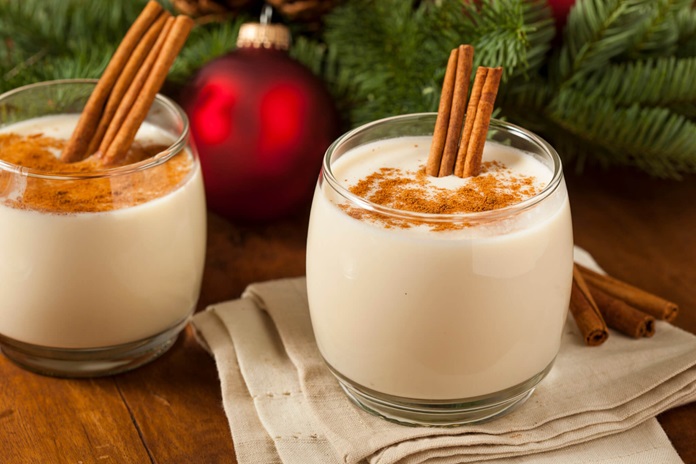Christmas Eve has become more festive with National Eggnog Day on December 24. You know, that drink you can only find in stores around the holidays. Eggnog, a sweet mix of milk, sugar, spices, cream, and eggs, has been a family favourite on the day before Christmas for centuries. For those looking to add an extra touch of celebration, you can also spike it with some liquor.
History of National Eggnog Day
Eggnog, also known as egg milk punch when alcohol is added, is a rich and creamy drink made from cream, milk, sugar, and whipped eggs, which give it a frothy texture. Liquor can be added but is not necessary, and the drink is usually served cold.
The exact origins of this festive holiday drink are widely debated, along with its main ingredients.
According to the Oxford English Dictionary, the term ‘nog’ referred to a type of strong beer brewed in East Anglia, England.
However, some believe eggnog originated in medieval Europe as a hot milk-based beverage.
Moreover, the term “eggnog” was first printed in the March 26, 1788 issue of the “New-Jersey Journal,” where it referred to a man enjoying a glass of the drink. There is still no consensus on how the name “eggnog” came to be.

One theory suggests the drink was originally called ‘grog’ and later changed to ‘eggnog.’ Other sources suggest that ‘nog’ was a term in Old English for a strong ale. Essentially, this means that “egg” and “nog” refer to any drink that includes both eggs and alcohol.
Eggnog might have also evolved from a popular British drink called posset, which was made with curdled milk mixed with wine and was often used for medicinal purposes. Later, in the 16th century, cream and a citrus base were added to the recipe.
Timeline of National Eggnog Day
| 13th Century (Monks Loved It) | According to “TIME” magazine, monks would frequently consume posset |
| 1820s (Special Concoctions) | An eggnog variation named Tom and Jerry is created. |
| 1826 (The Eggnog Riot) | A brawl between New York cadets at a Christmas party takes place after drinking vast amounts of eggnog. |
| 1900s (More Experiments) | Ponche Crema is another variation of eggnog, popular in Trinidad and Venezuela. |
| 2014 (Handle With Care) | A Utah resident named Ryan Roche is hospitalized after chugging non-alcoholic eggnog. |
5 Interesting Facts About Eggnog
- Featured on David Letterman: As part of his quirky Christmas traditions, David Letterman often used eggnog in some of his segments.
- That’s a lot of Eggnog: According to Indiana University, Americans consume over 135 million pounds of eggnog each year.
- George’s Marvelous Concoction: George Washington was a big fan of eggnog, and he loved making and serving it. His recipe has become quite famous.
- Starbucks Dropped It: When Starbucks removed the eggnog latte from its holiday menu, it caused an uproar and led to many complaints.
- Puerto Rico’s Coquito: In Puerto Rico, the local version of eggnog is called ‘coquito,’ made with cinnamon, coconut milk, rum, and sometimes whipped egg yolks.
Conclusion
In conclusion, National Eggnog Day on December 24 is more than just a celebration of a classic holiday beverage—it’s a tribute to the rich history and evolving traditions that eggnog represents. From its medieval European origins to its contemporary variations across cultures, eggnog remains a symbol of festive cheer and communal warmth.
As you enjoy this creamy concoction, whether with a traditional twist or a modern flair, take a moment to appreciate the way this time-honoured drink enhances the magic of the holiday season. Cheers to the enduring legacy of eggnog and the special moments it continues to bring to our celebrations.
Frequently Ask Question
1. What is National Eggnog Day?
National Eggnog Day, observed on December 24, celebrates the rich and creamy holiday beverage known as eggnog. It’s a day to enjoy this traditional drink that has been a festive favorite for centuries.
2. What is eggnog made of?
Eggnog is a sweet drink typically made from milk, cream, sugar, and whipped eggs. It has a frothy texture and can be enjoyed plain or with added liquor, such as rum or bourbon.
3. What is the history behind eggnog?
Eggnog’s exact origins are debated, but it is believed to have evolved from medieval European drinks like posset, which were made from curdled milk and wine. The term “eggnog” was first recorded in the March 26, 1788 issue of the “New-Jersey Journal.” The name may derive from “nog,” an Old English term for strong ale.
4. When did eggnog become popular?
Eggnog has been enjoyed for centuries, with early versions appearing in medieval Europe. It gained popularity in the United States over time, with notable events such as the 1826 Eggnog Riot and the creation of variations like Tom and Jerry in the 1820s.
You may also like to read, National Cookie Exchange Day – December 22, 2024
